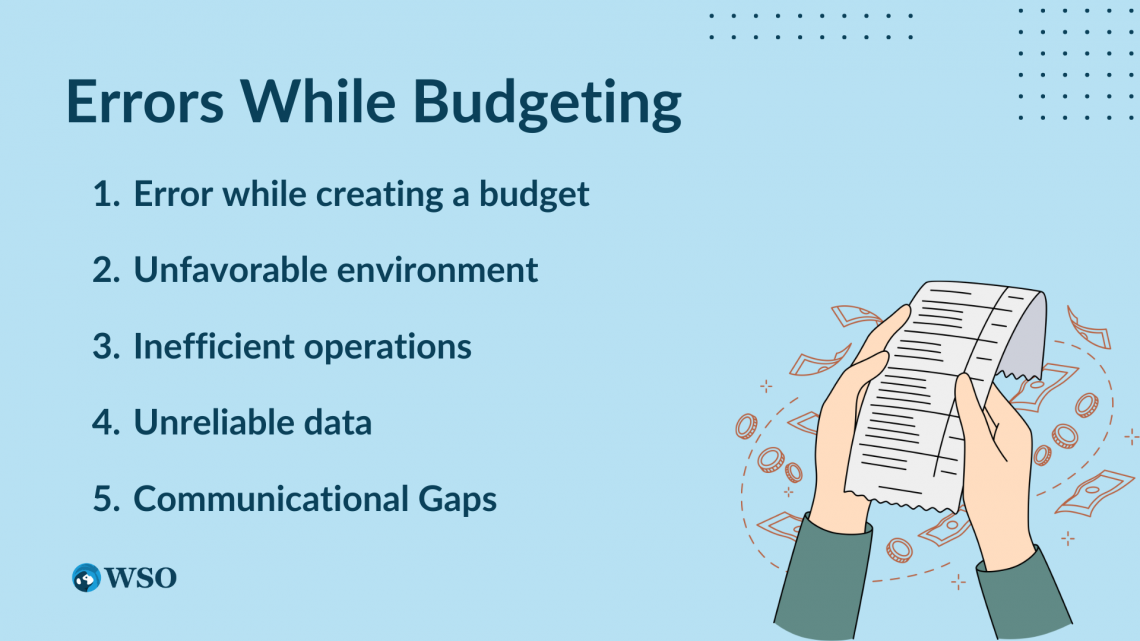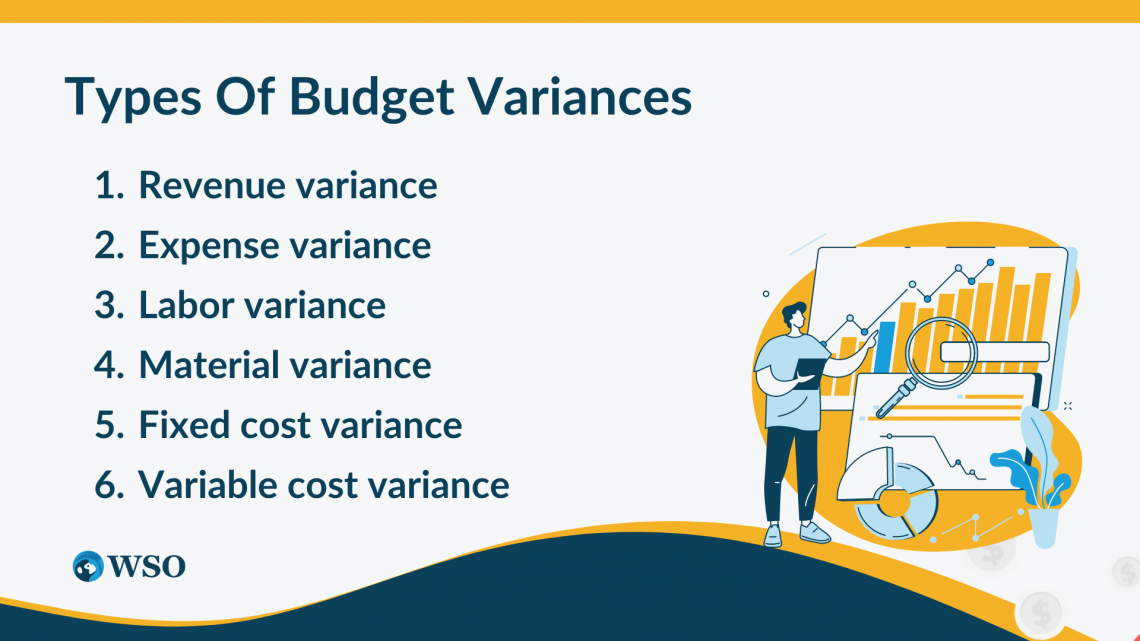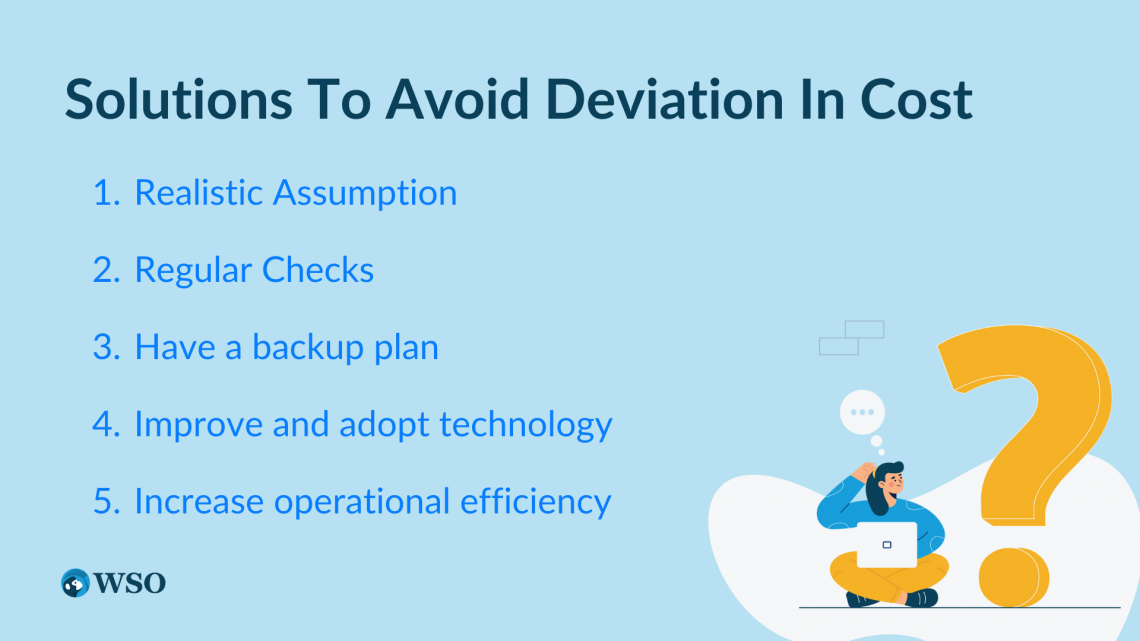Budget Variance
Budget variance is a statistical term used to calculate the difference between actual figures and budgeted figures.
Budgets are very part and parcel of any financial organization. It allows a firm to plan for overall outflows and inflows in a given year. After every financial year, the projected budget is compared with the actual budget, and the difference is called Budget variance.

Ideally, the projected and actual budgets always have a deviation in them. Hence the analysis of why a budget deviated from the projected budget is called variance analysis.
It can be calculated with two formulas:
Budget Variance = Actual amount - Budgeted amount
2. Percentage Variance formula
Budget Variance = (Actual amount/ Budgeted amount) - 1
The second formula calculates variance in percentage form.
Budget variance can be positive or negative. For example, if the actual amount is less than the budgeted amount, then the variance is positive variance and favorable for the company.
If the company's Actual budget exceeds the budgeted amount, then the variance is said to be negative and is usually not a good place for companies to be in.
Favorable variances usually occur when actual costs are much lower than assumed. This can be understood by an example.
If a company projects a budget of $50,000 but spends only $40,000, then the deviation would be positive $10,000 (50,000 - 40,000). In such a case, the deviation is positive, and the variance would be favorable.
A negative variance would be a reverse of the illustration given where if the deviation received is negative, it is termed unfavorable.
- Budget variance is when a budget deviates from its projected budget. There are various reasons for this to happen.
- The variance can either be positive or negative, depending upon the deviation.
- When the actual amount exceeds the budgeted amount, the variance is called negative variance.
- When the actual amount is lower than the projected budgeted amount, it is called a positive variance.
- Variances can occur due to multiple factors like errors while creating the budget, Unfavorable conditions, inefficiency in operations, and many more.
- A deviation from the budget is sometimes good, as explained in the article.
- A company is an evolving entity; hence, optimizing its operations continuously can tremendously bring down the cost of raw materials.
- Because of this continuous optimization, the company always aims to bring positive variance.
- Variance can be defined as good if it is positive for the company, but companies should avoid negative variance.
What are the errors while budgeting that causes budget variance?
Before understanding the types of variances, we must understand why these deviations occur. Well, there is no fixed answer to this question, as many factors may contribute to such deviations to occur.

1. Error while creating a budget
This is the most common error which may result in deviation from the actual budget. This phenomenon occurs when the budget creator makes wrong assumptions or different factors that influence the budgeting process.
Factors such as wrong data entry, Incorrect estimations, failure to collaborate between the stakeholders and other teams of the organization, and poor record-keeping methods may contribute to such errors.
Although companies and firms have now figured a way out by adopting new technology and budgeting software, the risk of error is much less than compared before, as software enables them to generate budgets without any error.
2. Unfavorable environment
An unfavorable environment may include an unexpected rise in the cost of raw materials, labor and a change in a nation's overall business and economic conditions.
For example, if a company has projected certain costs of raw materials and labor charges, A labor strike and a shortage in raw materials may lead to a deviation from the budget. In this case, the variance would be negative as the cost will increase in such conditions.
Companies can not exercise any control over such events as the market conditions that determine and influence the other factors.
There are various factors because of which a company can have unfavorable conditions. Some include economic slowdown, government regulation changes, natural disasters, political turmoil, and technological disruptions.
Out of all, technological disruptions are most damaging to the firm as it must invest in new technology to compete with other firms and sustain itself in the market.
In such hostile conditions, the company can not meet its expected cost or the projected budget and may exceed the budget planned for the firm.
3. Inefficient operations
This error occurs when unexpected costs are involved because of inefficiency in operations. One of the easiest errors to avoid having an operations team to monitor the firm's operations continuously can resolve this error.
For example, If a firm has a machine “A” with a certain lifespan and breaks down unexpectedly, then there is a cost associated with repairing machine “A.”
Such unexpected cases can be avoided by having the operations team manage and monitor the equipment and functioning of the machines.
The above examples are just some of the many causes that can result in a deviation from the budget. Deviation in the budget may give rise to different types of variances depending on the deviating factor.
Variances can be of many types depending on the type of deviation. They can be classified into different categories, such as Sales variance, Labor variance, Material variance, Volume variance, and Overhead Variance.
4. Unreliable data
As assumptions are based on past trends and previous data, it is important to have reliable, consistent data. However, starting is a challenge as they need more data to budget on historical data.
It is observed that companies and firms that make data-driven decisions are much more efficient and accurate than firms and organizations that do not have reliable information.
5. Communication Gaps
A firm functions more or less like humans. Hence, in the budgeting process, all the key functional parts of organizations contribute to the cost.
For example, the Marketing team may make assumptions of a certain amount for its advertising expense but has exceeded its budget for advertisement, which may result in deviations.
The above-given example is just one of many scenarios a firm may have. Hence a firm must communicate within the organization and across its cross-functional teams to plan its budget accordingly.
Types of budget variances
Depending on the deviation, various variances can occur; some common deviations and their variances are explained further.

1. Revenue variance
This refers to the difference between the projected and actual revenue budgets. A positive outcome is favorable, and a negative outcome is unfavorable to the firm.
Revenue variance = Projected Revenue - Actual Revenue
2. Expense variance
This refers to the difference in the expense category of the budget where a positive variance means that the firm was able to keep its expense below its projected expense, and a negative would mean vice versa.
Expense variance = Projected expense - Actual expense
3. Labor variance
This refers to the difference between budgeted and actual labor costs. A positive variance would mean that the labor cost for the financial year was much lower than the projected cost, and vice versa for a negative variance.
Labor Variance = Projected Labor cost - Actual Labor expense
4. Material variance
This refers to the difference between budgeted and actual material costs. A positive variance would mean that the material cost for the financial year was much lower than the projected cost, and vice versa for a negative variance.
Material Variance = Projected material cost - Actual material expense
5. Fixed cost variance
Although fixed costs are assumed to remain unchanged irrespective of any output level, there can be deviations even in a firm's fixed cost.
It refers to the difference between budgeted fixed costs to actual fixed costs. A positive variance would mean that the fixed cost for the financial year was much lower than the expected fixed cost.
Fixed cost Variance = Projected fixed cost - Actual fixed cost
6. Variable cost variance
This refers to the difference between budgeted variable cost to actual variable cost. A positive variance would mean that the variable cost for the financial year was much lower than the projected cost, and vice versa for a negative variance.
Variable Variance = Projected variable cost - Actual variable expense
It is important to note that the listed variances are some of many, but many more variances occur inside an organization. It is important to know that variances also have various types.
Is it possible to avoid budget variance?
A simple answer to that question would be “No.” Unfortunately, avoiding deviations from the budget is impossible, but it can be somewhat minimized. Below are some of the listed solutions to possibly avoid deviation in cost.

1. Realistic Assumption.
While creating a budget for an organization or firm, always keep assumptions as realistic as possible and use historical data to support your assumptions.
2. Regular Checks.
After creating the budget, regularly check and compare the actual costs with the projected costs. This helps in monitoring the budget and keeps them relevant.
3. Have a backup plan.
Although some variance can not be avoided because of an unfriendly environment, it's good to have a backup plan in place just in case something goes wrong.
4. Improve and adopt technology.
Technology may be your best friend in exercising control over the budget and helping you to predict budgets even more accurately than a human would.
5. Increase operational efficiency.
By increasing operational efficiency, any deviations in the budget because of machine breakdowns or other factors can be avoided.
Always recheck your budget with the actual budget; this will help you to have much more control over the costs and help you maintain a healthy balance sheet.
The suggested solutions may not eliminate the risk of deviation from the actual cost; they may help reduce the deviation.
Is Budget Variance Bad?
Not every time, As discussed earlier, deviations in the budget may be positive and negative. However, firms usually try to avoid negative deviations in the budget.

In most cases, companies prefer a deviation in the actual amount but not a negative deviation.
Although companies avoid negative deviations, A negative deviation gives room for the companies to think about what went wrong during the financial year and what steps can be taken to avoid such deviations.
A positive variance shows investors and stakeholders that the company is performing well. Generally, it means that the company is exceeding its projected performance which is considered a good sign.
It shows that the company is in a state to invest in growth and meet its financial debts, and also it means a larger share of dividends for investors.
The negative variance is the opposite of the positive variance mentioned. It means that the company needs to meet its expected rate of performance, which further signals that it is unable to sustain itself in the market.
The negative variance is often associated with a low rate of growth, a Higher debt rate, and a cut in shareholders of dividend funds.
Deviations or so-called variances are good for any firm till they show a positive variance, and a company always tries to keep its variance on the positive side. This is because a positive variance signals operational efficiency excellence to the firm's stakeholders.
A lot of concepts regarding this are covered in the WSO Accounting Foundations Course.
Budget Variance Summary
Budget variance is the difference between the expected or budgeted cost or revenue and the actual cost or revenue incurred by a business or a firm. It is an important tool that measures and reflects how much a company's financial performance deviates.

The actual amount spent or earned is removed from the budgeted amount to calculate budget variance. A negative variance occurs when the actual amount exceeds the budgeted amount, whereas a positive variance is vice versa.
Budget variance analysis can be conducted at the department or company-wide level, and it should be performed regularly to track performance and identify trends. There are various reasons why budget variances can occur.
Budget variance analysis is a crucial tool for businesses because it allows them to identify areas where they may have overspent or areas where the company did not put enough effort and take corrective action to improve future performance.
Identifying the underlying causes of variances is an important aspect of budget variance analysis. By implementing such actions, a company can take targeted corrective action to address the issue and prevent it from recurring in the future.

Companies should always try to keep their budgets in control and try to achieve maximum positive variance. But the company should prepare a budget in such a manner that it creates both values for itself and also values for the shareholders of the firm.
To summarize, budget variance analysis is a critical tool businesses use to evaluate their financial performance and identify areas for improvement.




or Want to Sign up with your social account?